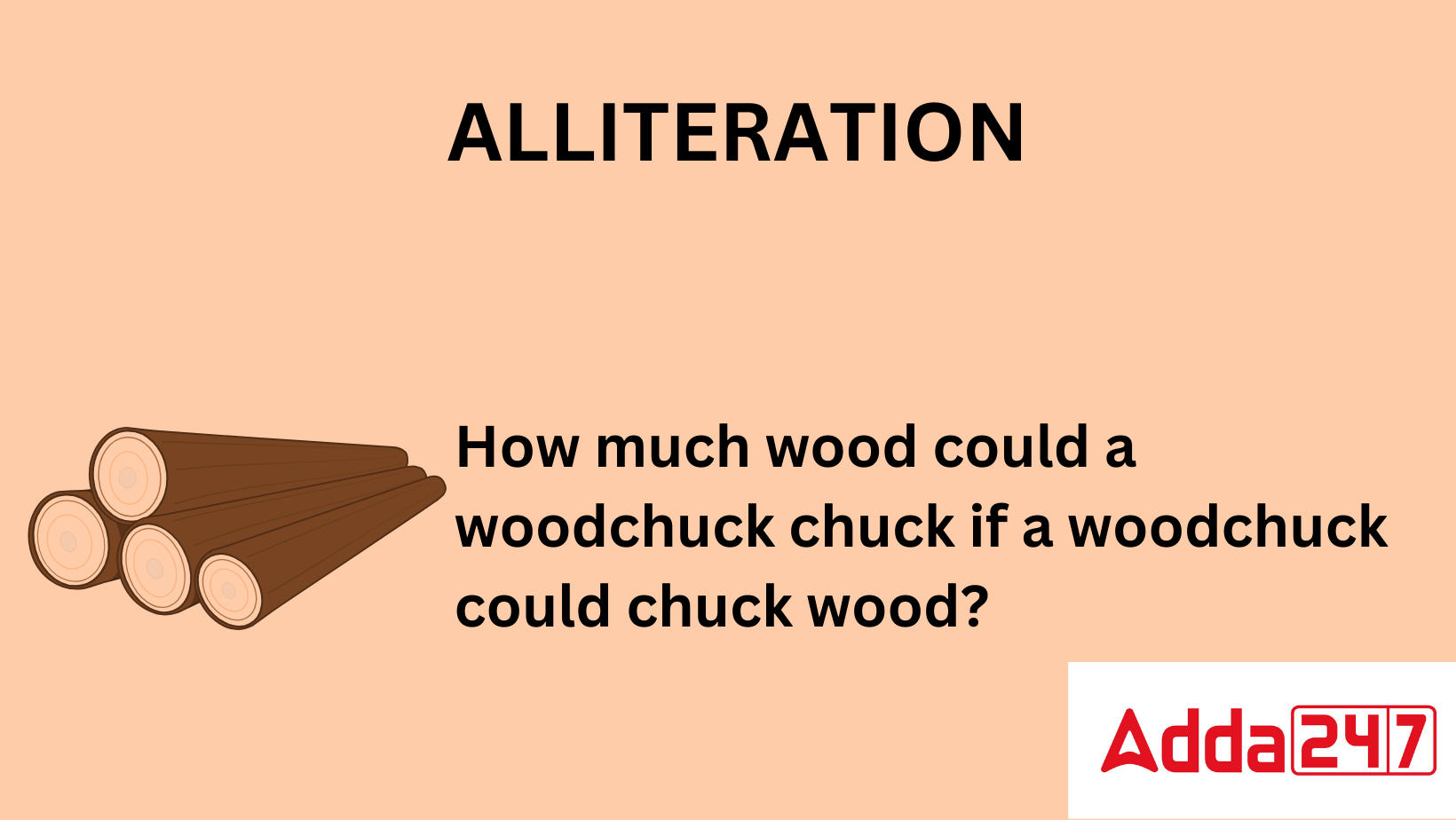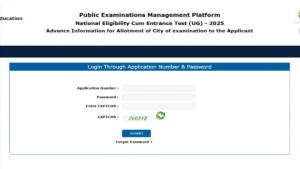Table of Contents
Alliteration Figure of Speech
Alliteration is a Figure of Speech. A literary device called alliteration, which means “letters of the alphabet,” originated from Latin. When two or more words with the same first consonant sound are combined, as in “fish fry,” it happens. Famous sentences that use alliteration include:
- Peter Piper picked a peck of pickled peppers.
- Sally sells seashells by the seashore.
- How much wood could a woodchuck chuck if a woodchuck could chuck wood?
What is Alliteration Poetic Device
Alliteration poetic device shows the practice of starting successive words with the same sound in order to create an audible rhythm that will give a piece of writing a loping, lyrical, and/or emotive effect.
The following paragraph is an example of alliteration
“Sanjeev did not know what love was, only what he thought it was not. It was not… returning to an empty carpeted condominium… turning away politely when the other men eventually put their arms around the waists of their wives and girlfriends… or working his way methodically through the major composers that the catalogue recommended.”
Alliteration Meaning and Definition
Alliteration is a literary device that creates a sense of continuity by using related phonetic sounds. Typically, this technique is applied to give the words a musical, lyrical, or emotive flair.
Alliteration is described as “the use of the same letter or sound at the beginning of words that are close to each other” in the Oxford Learner’s Dictionary. Alliteration is described as “the employment, especially in poetry, of the same sound or sounds, especially consonants, at the beginning of multiple words that are close to each other” by the Cambridge Dictionary.
The Collins Dictionary defines alliteration as “the use, in speech or writing, of several words close together that all begin with the same letter or sound,” and the Merriam-Webster Dictionary defines it as “the repetition of usually initial consonant sounds in two or more nearby words or syllables.”
How to use Alliteration in a sentence?
Alliteration in sentences appears to be a simple and engaging technique to improve the appearance and sound of your language. Your readers and listeners will pay more attention if you use repetition. Generally, anything that is repeated indicates that it is significant. Here, it produces a result. Because of this, tongue twisters sound so captivating. You can always utilise tongue twisters to interest your audience, whether you’re trying to teach them something or just have fun. You might have also encountered alliterative poetry.
Now, if you understand a few fundamental truths concerning alliteration, employing it will become simple. Look at the following details.
- Words having the same consonant or vowel sounds at the beginning are called alliteration.
- It is necessary to use these words sequentially, one after the other.
- Alliterated sentences can also be created using syllables with a similar sound.
There is no hard and fast rule that says you can only employ alliteration with certain terms. Just two words with a similar sound placed consecutively in a phrase can constitute it.
When attempting to apply alliteration in sentences, there is only one thing to keep in mind. Make sure your sentences have purpose. If a word doesn’t make sense, don’t put random words with similar sounds together.
Alliteration Examples
Take a look at the following common and well-known tongue twisters to see the use of alliteration.
- She sells sea shells on the seashore.
In this tongue twister, the words sells, sea, and sea are one alliteration group and she, shells and shore is another group.
- Betty bought a bit of butter but the butter was very bitter so Betty bought some better butter to make the bitter butter better.
This tongue twister uses the words bit, but, butter, bitter and better are used repetitively to create an effect and serve as an excellent example of alliteration.
Alliteration Examples in Literature
Examples of Alliteration from Literature
Let us take a look at some of the well-known examples of alliteration found in poetry.
Alliteration Example 1-
British Romantic poet Samuel Taylor Coleridge, in his poem The Rime of the Ancient Mariner, uses this literary device to enhance the musical rhythm of the poem.
“The fair breeze blew,
The white foam flew,
And the furrow followed free.
We were the first to ever burst into the silent sea.”
In the above example, the word pairs – breeze, blue; foam, flew; furrow, followed, free; and silent, sea are examples of alliteration.
Alliteration Example 2
In Sonnet 5, William Shakespeare makes some good use of alliteration. Let us take a look at an example.
“Those hours, that with gentle work did frame
The lovely gaze where every eye doth dwell,”
“Sap checked with frost, and lusty leaves quite gone,”
“their substance still lives sweet”
In this example, the word pairs – every, eye; doth, dwell; lusty, leaves; and substance, still are examples of alliteration.
Alliteration Example 3
You can also see an extensive use of alliteration in the famous Shakespearean play, Romeo and Juliet. Let us look at some of them now.
“The day to cheer and night’s dank dew to dry,”
“When griping grief the heart doth wound,
And doleful dumps the mind oppress,”
Similarly, Shakespeare uses alliteration in his play, Macbeth. Let us look at some examples
“Fair is foul, and foul is fair:
Hover through the fog and filthy air.”
“A heavy summons lies like lead upon me”
In the above examples, the words – day, dank, dew, dry; griping, grief; doleful, dumps; fair, foul, fog, filthy; and lies, like, lead are examples of alliteration.
Alliteration- (अनुप्रास)
अनुप्रास नामक एक साहित्यिक उपकरण, जिसका अर्थ लैटिन से उत्पन्न “वर्णमाला के अक्षर” है। जब एक ही पहली व्यंजन ध्वनि वाले दो या दो से अधिक शब्द संयुक्त होते हैं, जैसा कि “फिश फ्राई” में होता है। अनुप्रास का उपयोग करने वाले प्रसिद्ध वाक्यों में शामिल हैं:
पीटर पाइपर ने मसालेदार मिर्च का एक चुम्बन लिया।
सैली समुद्र के किनारे शंख बेचती है।
अगर एक लकड़हारा लकड़ी काट सकता है तो एक लकड़हारा कितनी लकड़ी काट सकता है?
अनुप्रास काव्य उपकरण
अनुप्रास काव्य उपकरण एक श्रव्य लय बनाने के लिए एक ही ध्वनि के साथ लगातार शब्दों को शुरू करने का अभ्यास दिखाता है जो एक लोपिंग, गीतात्मक और / या भावनात्मक प्रभाव लिखने का एक टुकड़ा देगा।
निम्नलिखित पैराग्राफ अनुप्रास अलंकार का एक उदाहरण है
“संजीव को नहीं पता था कि प्यार क्या होता है, बस वो जो सोचता था वो नहीं जानता था। यह नहीं था … एक खाली कालीन वाले कॉन्डोमिनियम में लौटना … विनम्रता से दूर जाना जब अन्य पुरुष अंततः अपनी पत्नियों और गर्लफ्रेंड की कमर के चारों ओर अपनी बाहें डालते हैं … या प्रमुख संगीतकारों के माध्यम से अपने तरीके से काम करते हैं जिसकी सिफारिश कैटलॉग ने की थी।”
Alliteration Meaning in Hindi
Alliteration Meaning in Hindi: अनुप्रास एक साहित्यिक उपकरण है जो संबंधित ध्वन्यात्मक ध्वनियों का उपयोग करके निरंतरता की भावना पैदा करता है। विशिष्ट रूप से, इस तकनीक का उपयोग शब्दों को एक संगीतात्मक, गीतात्मक, या भावनात्मक स्वभाव देने के लिए किया जाता है।
अनुप्रास को ऑक्सफोर्ड लर्नर्स डिक्शनरी में “शब्दों की शुरुआत में एक ही अक्षर या ध्वनि का उपयोग जो एक दूसरे के करीब हैं” के रूप में वर्णित किया गया है। कैंब्रिज डिक्शनरी द्वारा अनुप्रास को “रोजगार, विशेष रूप से कविता में, एक ही ध्वनि या ध्वनि, विशेष रूप से व्यंजन, कई शब्दों की शुरुआत में जो एक दूसरे के करीब हैं” के रूप में वर्णित किया गया है।
कोलिन्स डिक्शनरी ने अनुप्रास को “भाषण या लेखन में, एक साथ कई शब्दों का उपयोग, जो सभी एक ही अक्षर या ध्वनि से शुरू होते हैं” के रूप में परिभाषित किया है, और मरियम-वेबस्टर डिक्शनरी ने इसे “दो में आमतौर पर प्रारंभिक व्यंजन ध्वनियों की पुनरावृत्ति” के रूप में परिभाषित किया है। या अधिक पास के शब्द या शब्दांश।”
Alliteration Figure of Speech in Hindi
आपकी भाषा की उपस्थिति और ध्वनि को बेहतर बनाने के लिए वाक्यों में अनुप्रास एक सरल और आकर्षक तकनीक प्रतीत होती है। यदि आप दोहराव का उपयोग करते हैं तो आपके पाठक और श्रोता अधिक ध्यान देंगे। आम तौर पर, जो कुछ भी दोहराया जाता है वह इंगित करता है कि यह महत्वपूर्ण है। यहाँ, यह एक परिणाम पैदा करता है। इस वजह से टंग ट्विस्टर्स की आवाज बहुत ही मनमोहक होती है। आप हमेशा अपने दर्शकों को आकर्षित करने के लिए जीभ जुड़वाँ का उपयोग कर सकते हैं, चाहे आप उन्हें कुछ सिखाने की कोशिश कर रहे हों या बस मज़े कर रहे हों। आपने अलंकारिक काव्य का भी सामना किया होगा।
अब, यदि आप अनुप्रास से संबंधित कुछ मूलभूत सत्यों को समझ लें, तो इसका प्रयोग करना सरल हो जाएगा। निम्नलिखित विवरण देखें।
जिन शब्दों के प्रारंभ में एक ही व्यंजन या स्वर का उच्चारण होता है, वे अनुप्रास कहलाते हैं।
इन शब्दों का प्रयोग क्रमानुसार, एक के बाद एक करना आवश्यक है।
समान ध्वनि वाले शब्दांशों का उपयोग करके अलंकृत वाक्य भी बनाए जा सकते हैं।
कोई कठिन और तेज़ नियम नहीं है जो कहता है कि आप अनुप्रास का प्रयोग केवल कुछ शर्तों के साथ ही कर सकते हैं। एक वाक्यांश में लगातार समान ध्वनि वाले दो शब्द इसे बना सकते हैं।
वाक्यों में अनुप्रास अलंकार का प्रयोग करते समय केवल एक ही बात का ध्यान रखना चाहिए। सुनिश्चित करें कि आपके वाक्यों का उद्देश्य है। यदि कोई शब्द समझ में नहीं आता है, तो समान ध्वनियों वाले यादृच्छिक शब्दों को एक साथ न रखें।
Alliteration Examples in Hindi
अनुप्रास के उपयोग को देखने के लिए निम्नलिखित सामान्य और प्रसिद्ध टंग ट्विस्टर्स पर एक नज़र डालें।
वह समुद्र के किनारे सीपियां बेचती है।
इस टंग ट्विस्टर में, शब्द बिकता है, समुद्र और समुद्र एक अनुप्रास समूह हैं और वह, गोले और किनारे एक और समूह है।
बेट्टी ने थोड़ा मक्खन खरीदा लेकिन मक्खन बहुत कड़वा था इसलिए कड़वे मक्खन को बेहतर बनाने के लिए बेट्टी ने कुछ बेहतर मक्खन खरीदा।
यह टंग ट्विस्टर शब्द बिट का उपयोग करता है, लेकिन, मक्खन, कड़वा और बेहतर प्रभाव पैदा करने के लिए दोहराव से उपयोग किया जाता है और अनुप्रास के उत्कृष्ट उदाहरण के रूप में काम करता है।
साहित्य में अनुप्रास उदाहरण
साहित्य से अनुप्रास के उदाहरण
आइए कविता में पाए जाने वाले अनुप्रास के कुछ प्रसिद्ध उदाहरणों पर एक नज़र डालें।
उदाहरण 1-
ब्रिटिश रोमांटिक कवि सैमुअल टेलर कोलरिज ने अपनी कविता द राइम ऑफ़ द एंशिएंट मेरिनर में कविता की संगीतमय लय को बढ़ाने के लिए इस साहित्यिक उपकरण का उपयोग किया है।
“निष्पक्ष हवा चल रही थी,
सफेद झाग उड़ गया,
और फरो मुक्त पीछा किया।
हम मौन समुद्र में सबसे पहले फूटने वाले थे।”
उपरोक्त उदाहरण में, शब्द जोड़े – हवा, नीला; फोम, उड़ गया; फरो, फॉलो, फ्री; और मौन, समुद्र अनुप्रास के उदाहरण हैं।
उदाहरण 2
गाथा 5 में, विलियम शेक्सपियर अनुप्रास का कुछ अच्छा उपयोग करते हैं। आइए एक उदाहरण देखें।
“वे घंटे, जो कोमल काम के साथ बने थे
वह प्यारी नज़र जहाँ हर आँख बसती है,”
“ठंढ के साथ सैप की जाँच की गई, और रसीले पत्ते बिल्कुल चले गए,”
“उनका पदार्थ अभी भी मीठा रहता है”
इस उदाहरण में, शब्द जोड़े – प्रत्येक, आँख; करते हैं, निवास करते हैं; लस्टी, पत्ते; और पदार्थ, अभी भी अनुप्रास के उदाहरण हैं।
उदाहरण 3
आप एक व्यापक यू भी देख सकते हैं
शेक्सपियर के प्रसिद्ध नाटक, रोमियो और जूलियट में अनुप्रास से। आइए अब उनमें से कुछ को देखें।
“खुश करने का दिन और रात की ओस सूखने के लिए,”
“जब दुःख दर्द होता है तो दिल घायल हो जाता है,
और उदास मन को दबा देता है, दमन करता है,
इसी तरह, शेक्सपियर अपने नाटक मैकबेथ में अनुप्रास का प्रयोग करता है। आइए कुछ उदाहरण देखें
“निष्पक्षता ही बेईमानी है और बेईमानी ही निष्पक्षता है:
कोहरे और गंदी हवा में होवर करें।”
“एक भारी सम्मन मेरे ऊपर लीड की तरह है”
उपरोक्त उदाहरणों में, शब्द – दिन, नम, ओस, सूखा; तड़पना, दु: ख; शोकाकुल, डंप; निष्पक्ष, बेईमानी, कोहरा, गंदी; और झूठ, जैसे, सीसा अनुप्रास के उदाहरण हैं।
Know more:
| Simile | Antithesis |
| Metaphor | Oxymoron |
| Personification | Epigram |
| Apostrophe | Irony |
| Alliteration | Pun |
| Assonance | Metonymy |
| Hyperbole | Synecdoche |
| Euphemism | Transferred Epithet |



 NEET City Intimation Slip 2025 Out at ne...
NEET City Intimation Slip 2025 Out at ne...
 NEET Passing Marks Out of 720, Check NEE...
NEET Passing Marks Out of 720, Check NEE...
 NEET Total Marks- Check NEET Marks Distr...
NEET Total Marks- Check NEET Marks Distr...










